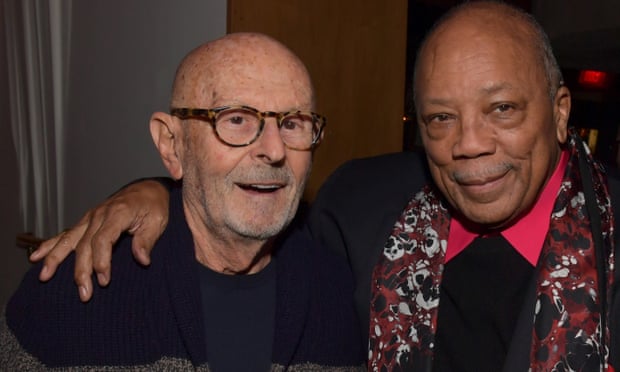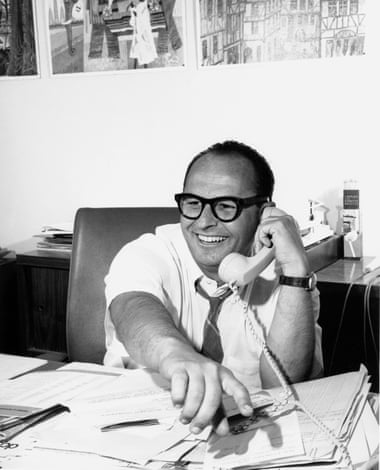It is usually the artists who are the household names in the music business, but there have been a handful of executives who became well known in their own right, such as Clive Davis at Columbia Records and Ahmet Ertegun at Atlantic. One of the greats was Mo Ostin, who was renowned as a champion of music and musicians. During his 30-year career with Warner Bros, Ostin, who has died aged 95, was instrumental in building the careers of many of the most highly regarded artists of his era.
After working for Norman Granz’s jazz label Verve in the mid-1950s, Ostin was picked by Frank Sinatra to head his label Reprise. After that was bought by Warner Bros, Ostin helped bring the world the Kinks, Joni Mitchell, James Taylor, Fleetwood Mac, Madonna and Prince, while Paul Simon, Tom Petty and REM also flourished under his sympathetic regime.
In the mid-70s, Warner-Reprise had become the top label in the US, and the WEA grouping of which it was a part controlled almost a quarter of the US music market. Fleetwood Mac’s 30m-selling album Rumours proved a high-watermark for the company.
Another prestigious signing was Neil Young, who inducted Ostin into the Rock and Roll Hall of Fame in 2003. “Mo is just the greatest,” said Young, “and he brought something to my life that made a big difference, and it was creative freedom.”
In reply, Ostin outlined the key lesson he had learned: “This is a business of creativity and risk-taking and passion, and, in the struggle between art and commerce, the artist must prevail.”
He was born in New York as Morris Ostrofsky, to Berta (nee Shaffer) and Abraham Ostrofsky, who had fled Russia to escape the Bolshevik revolution. When he was 13 he moved with his parents and brother, Gerald, to Los Angeles, where they lived in the Fairfax district and ran a small fresh produce market.
Ostin attended Fairfax high school, where he headed the music society, and then went to UCLA to study economics. His introduction to the music business came via the family’s next-door neighbour Irving Granz, whose brother Norman ran the Clef Records jazz label. While still at university, Ostin travelled with Granz’s Jazz at the Philharmonic concerts, selling programmes. He had graduated in economics, but then dropped out of UCLA’s law school to become controller at Clef. The label was renamed Verve and was home to jazz artists including Ella Fitzgerald, Duke Ellington and Charlie Parker.
In 1960 Ostin found himself being headhunted by Sinatra, who, having unsuccessfully tried to buy Verve, recruited him as general manager at his new label, Reprise. Sinatra aside, Reprise’s roster was focused around Sinatra’s Rat Pack pals and looked outdated, but broader horizons opened up when Reprise was bought by Warner Bros.
Ostin’s ears were acutely attuned to the revolutionary upheavals that were transforming the music business, as he demonstrated by signing the Kinks in 1964. The band scored six Top 40 hits in the US by the end of 1965.
In 1967 he signed Jimi Hendrix, when the guitarist had barely been heard of outside Britain. Further far-sighted additions were Fleetwood Mac, Jethro Tull and the Grateful Dead. While Sinatra could never learn to love rock’n’roll music, Ostin appreciated how “Frank’s whole idea was to create an environment which, both artistically and economically, would be more attractive for the artist than anybody else had to offer … One of the great things about Warners, I always felt, was our emphasis and priority was always about the music.”
Assisted by his head of A&R, Lenny Waronker, who assembled an impressive talent-spotting team that included Ted Templeman, Russ Titelman and Gary Katz (known for his production work on Steely Dan’s albums), Ostin was able to develop a roster that included many distinctive and influential artists. Randy Newman, Joni Mitchell and Taylor lined up alongside Bonnie Raitt, Van Dyke Parks, Little Feat and Van Morrison, while Young became almost an in-house talisman at Reprise, his aura attracting other gifted artists to the label. By 1970, Ostin had become chairman and chief executive of Warner-Reprise, a post he held until 1994.
Ostin’s magnetism ensured that artists kept beating a path to his door – he ran the Warner-Reprise operation from the so-called “Ski Lodge”, a multi-level wooden building in Burbank – with Van Halen, ZZ Top, the B-52s, George Benson, Petty, Simon, REM, Rickie Lee Jones, Rod Stewart and Dire Straits among them. A distribution deal with Sire Records also brought Madonna, the Ramones and Talking Heads into the fold.
Ostin was especially proud of signing Prince in 1977, when the nascent superstar was 19. Ostin recalled how they heard a Prince demo tape “and we were absolutely blown away and wanted to sign him immediately. There was a lot of competition because other people knew about him … Because we valued artists, he signed with us.”

In 1994 the Ostin era at Warners began to draw to a close as he found himself in a power struggle with Robert Morgado, the chairman of what was now known as Warner Music Group. Ostin resigned, temporarily throwing Warners into chaos. “Warner is a different company now than the company I was brought up in,” Ostin explained. “And in the end, I found it impossible to operate in that kind of environment.”
In 1995, Ostin, Waronker and Ostin’s son Michael signed on as the new management team at DreamWorks SKG Records, part of the entertainment monolith created by David Geffen, Steven Spielberg and Jeffrey Katzenberg. However, despite signing Rufus Wainwright, George Michael and Nelly Furtado, the label failed to live up to its potential. Ostin retired from the music industry in 2004, after it was sold to Universal Music Group. In 2006 he took a consulting role at Warner Bros Records, with the title of chairman emeritus.
Ostin’s wife, Evelyn (nee Bardavid), whom he married in 1948, died in 2005. Two of their sons, Randy and Kenny, also predeceased him. Ostin is survived by Michael and Gerald.

